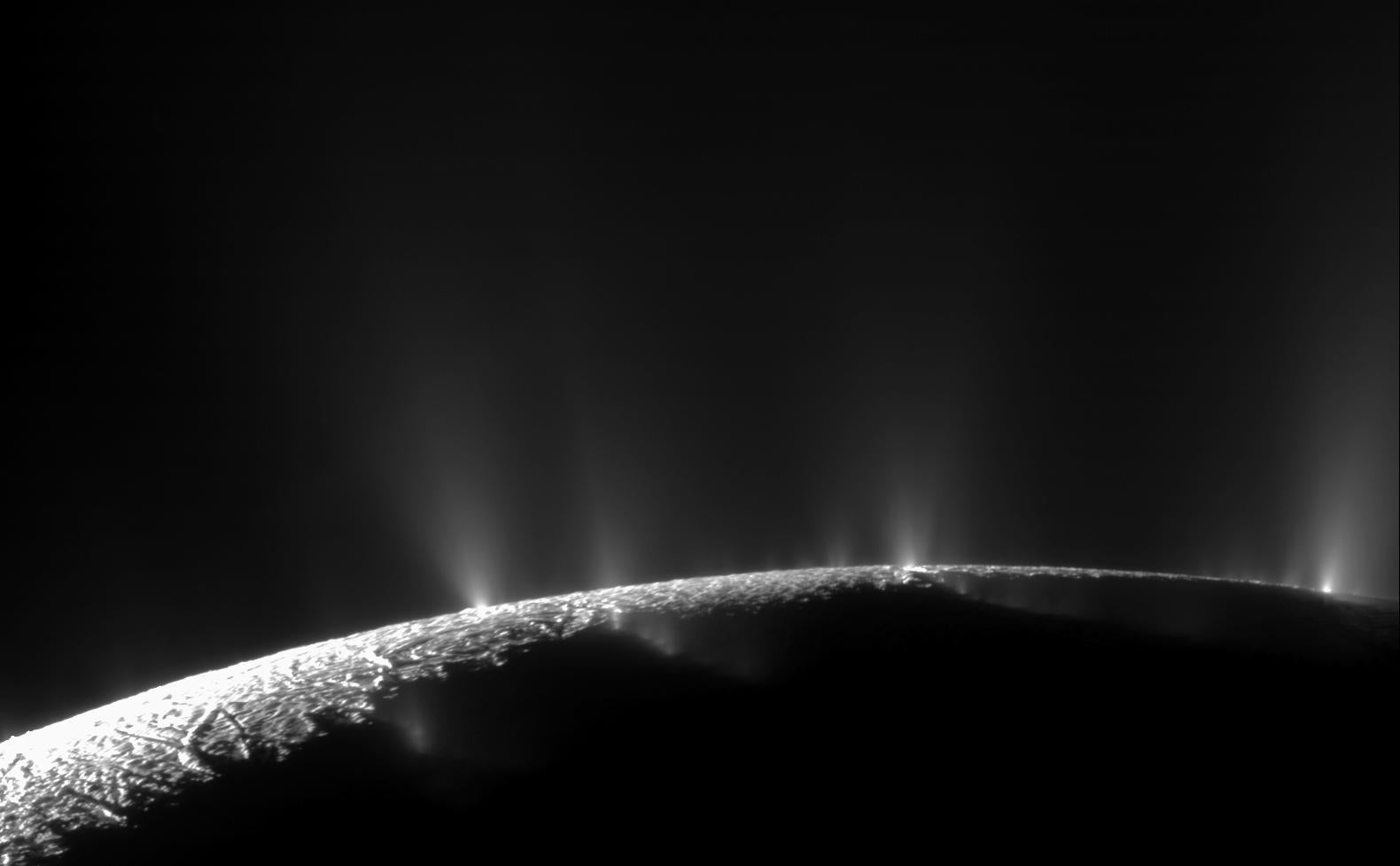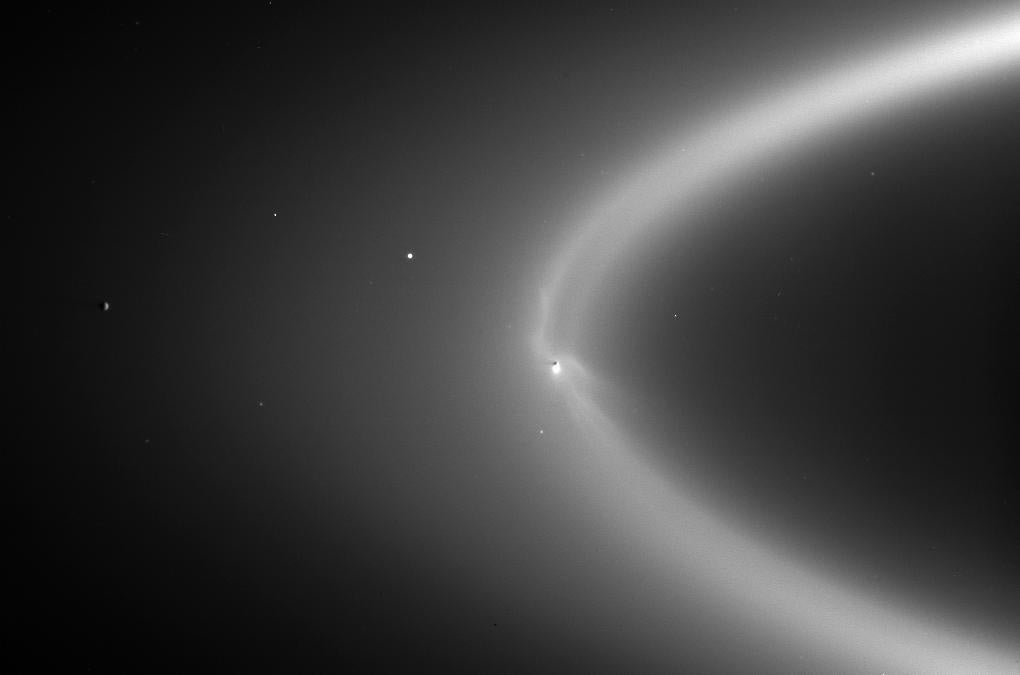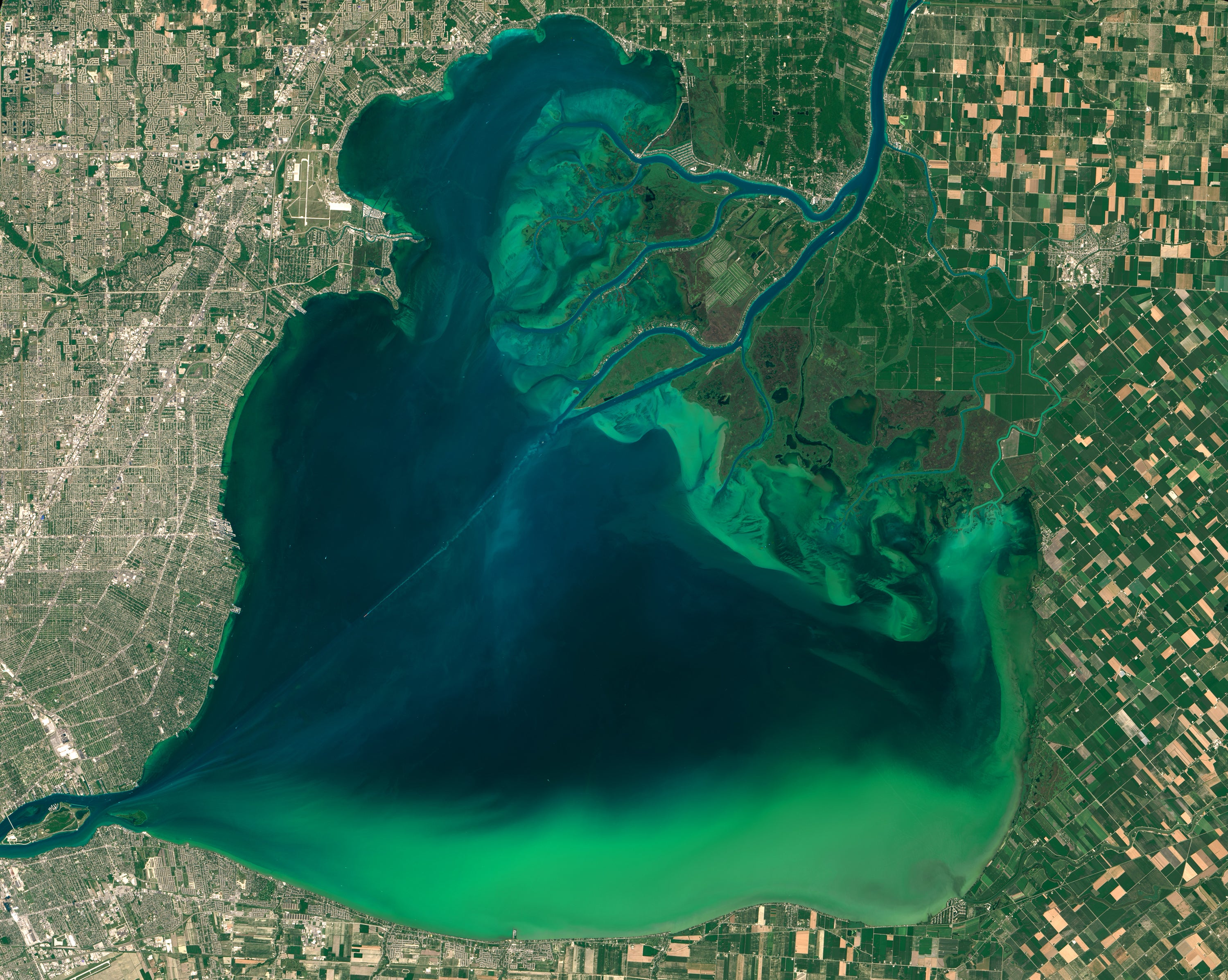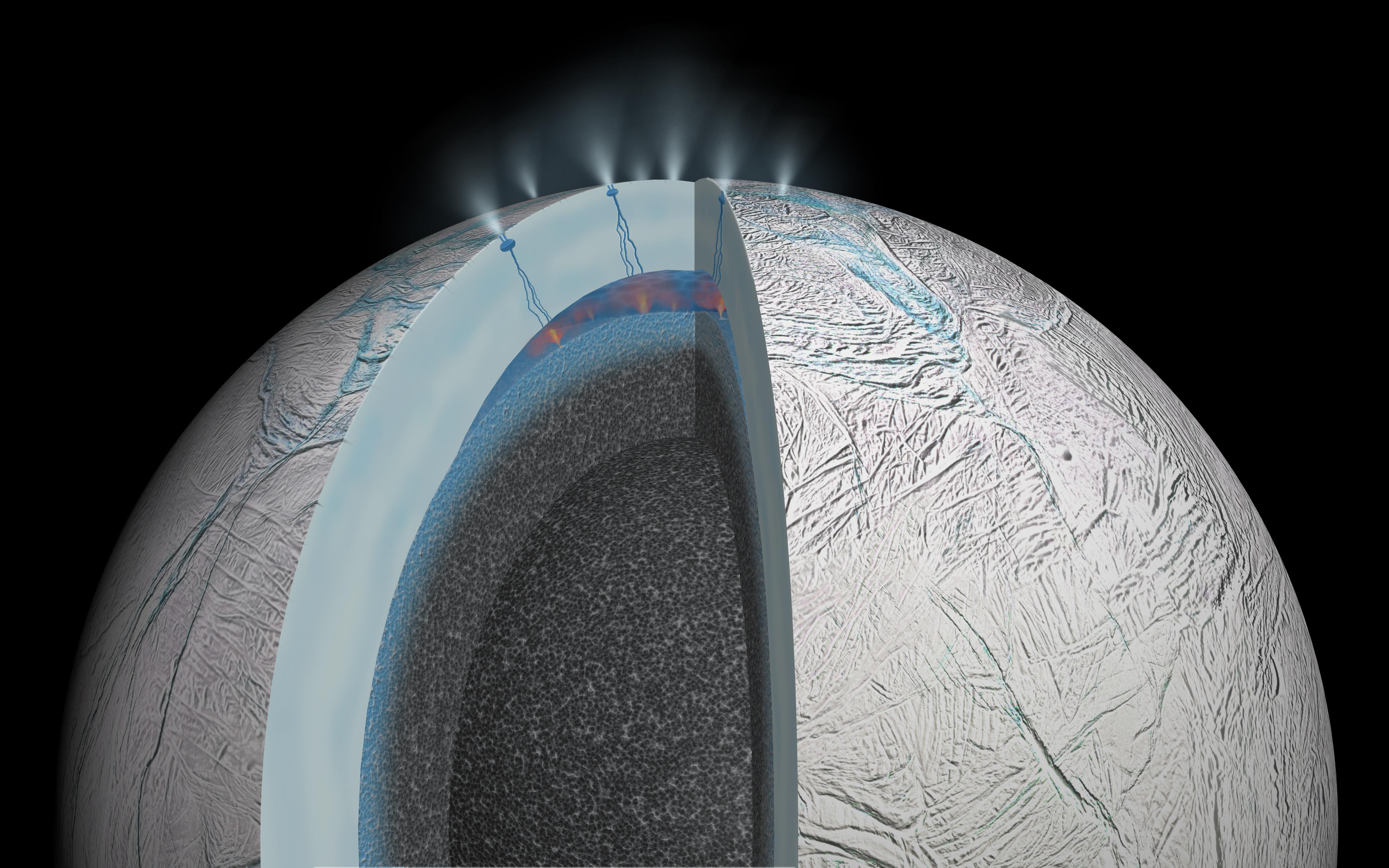
According to legend, the ancient giant Enceladus vents sulfur from his tomb. According to data, Saturn’s tiny moon Enceladus vents more than that.
In a new analysis of data from the retired Cassini mission to Saturn, an international team of researchers say they have detected phosphorus — a key ingredient for life — coming from Enceladus’ subsurface warm, salty ocean. The report means scientists have found evidence at Enceladus for the six most critical elements needed for life as we know it.
Those elements are known collectively by the acronym CHNOPS: carbon, hydrogen, nitrogen, oxygen, phosphorus and sulfur. Because phosphate is so vital to life, the fact that it had not yet been found at Enceladus was once considered a show-stopper. But now, Enceladus is the only other place in the solar system besides Earth with compelling evidence for all six, opening the door for life to potentially exist beneath the moon’s icy surface.
The study was led by Frank Postberg, a planetary scientist at the Free University of Berlin in Germany, and published June 14 in Nature.
Postberg told Astronomy that while further study is needed to determine the exact amount of phosphorus present at Enceladus, he thinks the detection is “absolutely bullet-proof.” (In fact, the weakest detection of the six CHNOPS elements at Enceladus is now sulfur.)
Even better, says Postberg, is that the phosphate found there is soluble, meaning it can dissolve in water and is therefore available to use by any possible life.
“A big deal”
Enceladus is covered by a 12-mile-thick (20 km) crust of highly reflective ice that betrays many signs of geological activity. In places, there are old impact craters, but much of the terrain is young and worked over by active ice tectonics. There are ridges, scarps, plains, groves, and troughs, and, at the south pole, four “tiger stripes” — which are fractures bordered by ridges. Some parts of this region may be as young as 500,000 years.
From these cracks, geysers of water ice stream out into space, forming a plume over the moon’s south pole that was first seen by Cassini nearly two decades ago. The James Webb Space Telescope (JWST) recently caught a 6,200-mile-long (10,000 km) spray ejecting nearly 80 gallons of water (300 liters) per second — enough to fill an Olympic-sized swimming pool in just a couple of hours.

At just 310 miles (500 kilometers) wide, Enceladus is too small to generate energy on its own. But the moon is flexed by Saturn’s gravity, providing energy for the cold, dark ocean, which could be 25 miles (40 km) deep. Beneath the ocean floor, the moon’s core seems to be unusually hot. That could mean the existence of hot hydrothermal vents like those in Earth’s oceans — and those teem with microscopic and macroscopic life.
This ocean has long been considered one of the best places to search for life in the solar system. But before this work, scientists had not yet found all of the most important ingredients for life.
Postberg says his team did not set out specifically to look for phosphates but rather, “anything new” in the Cassini data. But he realized “pretty quickly” that a mass spectrometry signal that was “previously unknown” was “probably phosphate,” though several months passed before he was fully convinced.
“That was an exciting and tantalizing moment,” Postberg said. “However, not being an astrobiologist, I … underestimated [a little bit] the significance of the finding.” It took his colleagues to tell him that this was “a big deal.”
The team found the sodium phosphate in data from Cassini’s Cosmic Dust Analyzer (CDA) — an impressive feat considering the instrument wasn’t designed for such a detection. The team boosted its signal by gathering samples from not just the plume itself but also from the E-ring, a diffuse ring of Saturn fed by the plume.

The find was not entirely unexpected by the scientists. The American researcher on the Nature study, extraterrestrial oceanographer Christopher Glein of the Southwest Research Institute in San Antonio, Texas, recently co-published models that suggested that phosphorus could be “an inevitable consequence” of the chemistry of Enceladus.
“Although this discovery was consistent with our previous geochemical models, I was still shocked,” Glein told Astronomy. “It was very exciting because of the implications for habitability, and prior to the discovery, I don’t think anyone thought that a minor element like phosphorus could be found using Cassini data. That mission wasn’t designed to search for phosphorus in samples of frozen extraterrestrial ocean water. Frank might have been the only person in the world who thought this was possible, and he pulled it off.”
The last part of the puzzle was provided by Yasuhito Sekine at the Tokyo Institute of Technology, who had performed laboratory experiments that “ended up providing a beautiful demonstration” that phosphorus could abound in Enceladus’ fizzy ocean, says Glein. “I think we now have a very good understanding of phosphorus on Enceladus,” he adds.
Life finds a way?
Some scientists say that the finding substantially increases the odds of finding life elsewhere in the solar system.
Phosphates are critical to life’s most important molecules — DNA and RNA — as well as to walls of cells. The concentration of phosphates in the Enceladus ocean is at least 100 times more than that found in Earth’s oceans. And Postberg says that estimate is quite conservative. The carbonated quality of Enceladus’ ocean is more conducive to dissolving phosphorus than in terrestrial seas. This suggests similar chemistry on other ocean worlds.

Nathalie Cabrol, Director of the Carl Sagan Center for the Study of Life in the Universe at the SETI Institute, said the phosphorus detection was exciting. Asked to rank that excitement from one to 10, she called it a 20.
Cabrol stresses that we don’t know that life is there. But the elements for the possibility of life are. And methane — which can be a byproduct of life — has also been found in the plumes erupting from below the ice on Enceladus.
“Enceladus is habitable (for life) as we know it,” she says. “This little world is really tantalizing.” Cabrol believes that the various geysers can “tell us something about the composition of the floor” of Enceladus. “We can maybe map the bottom of the ocean by just sampling those geysers,” she adds.
What’s next
Cassini explored the Saturn system from 2004 until 2017, when it plunged into the planet and burned up. But new missions are looming.
Even before the phosphate findings, Enceladus was high on scientists’ target list. A combination orbiter and lander — nicknamed the “Orbilander” — was named as the second-highest priority for a NASA flagship mission in the next two decades, according to last year’s decadal survey. The survey is a consensus of the global planetary science community’s mission goals. Orbilander would circle the moon for a year and a half, then descend to the surface and look for life for the next two years.
“This is the mission that I would love to do,” says Glein. “It’s bold, inspiring, it has the potential to revolutionize science, and it would be a testament to continued U.S. leadership in space. To make it happen, we need strong and consistent budgetary support of NASA. We will also need visionaries.”

We may not have to wait till the 2050s for a probe to reach this possible abode of life. The decadal also included a call for a faster, cheaper mission (a New Frontiers-class mission, in NASA parlance) that could reach Enceladus later this decade or into the early 2030s. This would be a spacecraft that would conduct several flybys of the moon and fly into those promising plumes. Several teams are interested in proposing such a mission.
“Enceladus may be one of our best chances to find extant life in our solar system,” says Regis Ferriere, a professor of ecology and evolutionary biology at the University of Arizona in Tucson. He was one of the authors of a 2021 paper that argued the plumes of Enceladus make more sense chemically if microbes are present in its ocean.
Cabrol says that getting to Enceladus or another icy ocean world — missions to Europa are also on the book — will help us understand the “template” for all of them, including Pluto and Titan.
Says Glein, “We are learning that the ingredients for life appear to be common in the solar system. One of the biggest discoveries over the past 20 years is that the outer solar system is wet. Liquid water is underground out there. This may bode well for finding evidence of life, if the origin of life is a likely consequence of planetary processes involving liquid water, organic molecules, and minerals.”
Soon enough, we may find out if this is correct.
Editor’s note: A few of the details in this story have been updated for accuracy with information from Glein.









